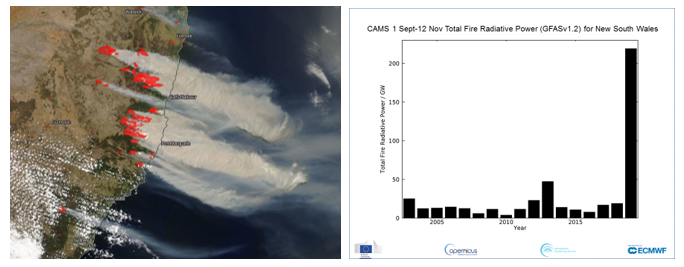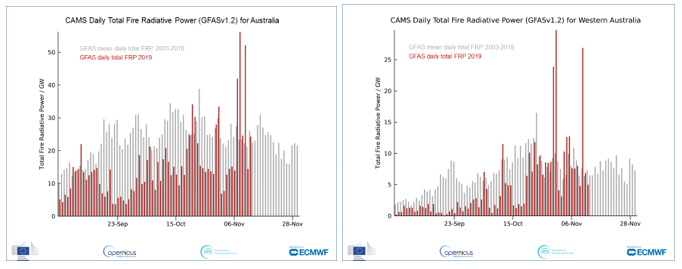Catastrophic effects of ‘unprecedented’ Australian bushfires
-

With the raging wildfires, widespread air quality issues, caused by very high surface particulate matter values, will affect many people over the coming days, latest Copernicus Atmosphere Monitoring Service forecasts reveal.
As significant numbers of bushfires burn in New South Wales and Queensland, Australia, the Copernicus Atmosphere Monitoring Service (CAMS), monitors their intensity and emissions. Data collected by CAMS shows that the fires are unprecedented when compared to the previous 16 years for New South Wales.
CAMS, which is implemented by the European Centre for Medium-Range Weather Forecasts on behalf of the European Union, provides daily estimates of global fire emissions with its Global Fire Assimilation System (GFAS), which assimilates fire radiative power (FRP) observations from satellite-based sensors.

Recent satellite imagery shows massive smoke plumes over New South Wales and Queensland, turning day into night in some areas. The fires have even been burning in the kind of intensity never experienced before in places usually not seriously affected such as Northern New South Wales and tropical Queensland and according to scientists. Smoke from the fires has been transported beyond New Zealand and over the South Pacific Ocean with satellite observations showing that it may reach South America in coming days.

The monthly hydrological summaries of the Copernicus Climate Change Service (C3S), also implemented by ECMWF, showed August, September and October anomalies with high positive resp. dry values for eastern Australia, that are consistent with long-term drought conditions and are contributing to the current fire conditions. Most of the extratropical Southern Hemisphere, particularly in Australia and the southern part of Africa are currently experiencing drier than usual conditions.
Very high surface atmospheric particulate matter has also been causing air quality issues with New South Wales declaring a state of emergency in the wake of fires.

Fires, not only in Australia, but worldwide, can now be tracked by users of the App, Windy, which has added a new map “Active fires”. Input for the new layer is provided by the Copernicus Global Fire Assimilation System (GFAS) and displays the daily average of the fire radiative power (FRP).
CAMS Senior Scientist, Mark Parrington, comments: “We have been closely monitoring the intensity of the fires and the smoke they emit and when comparing the results with the average from a 17-year period, they are very unusual in number and intensity, especially in New South Wales, for being so early in the fire season.”
For further information visit atmosphere.copernicus.eu/global-fire-emissions
https://www.windy.com/-PM2-5-pm2p5?cams,pm2p5,-32.584,150.073,5,internal